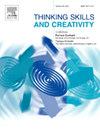How teacher autonomy support and student creativity jointly contribute to self-regulated learning: a dynamic, person-environment fit perspective
IF 4.5
2区 教育学
Q1 Social Sciences
引用次数: 0
Abstract
According to emergent research, being creative at school could benefit self-regulated learning, but only within “creative learning” contexts that encourage student creativity. This study explored these relations among vocational students in high school (N = 8224). Theoretically, it merged creativity research and self-determination theory (Ryan & Deci, 2020) by operationalising creative-supportive contexts as teaching that supports the need for autonomous learning. Methodologically, the study investigated reciprocal influences between student perceptions of creativity (i.e., use of creative cognitive processes while studying), teacher autonomy support (i.e., teacher behaviours that foster autonomous learning behaviour) and self-regulation (i.e., regulation of resources, efforts, motivation in learning activities), while accounting for different temporalities of effects (i.e., lagged vs. contemporaneous) and for the possibility that self-regulation responds to a process of fit between student creativity and teacher autonomy support. Overall, results from random-intercept cross-lagged panel models and cubic response surface analysis revealed complex patterns of relations. Whereas self-regulation predicted positive changes in creativity and autonomy support over time (lagged effects), the reciprocal effects on self-regulation appeared instead to be contemporaneous and to be optimal when both creativity and autonomy support were present (person-environment fit). Moreover, teacher autonomy support played a dual role, partly compensating for low creativity to maintain adequate self-regulation, and partly increasing creativity among students. Implications on reciprocal relations between creativity and self-regulation, on fostering creative learning contexts via teacher autonomy support, and on modelling strategies in creativity research are discussed.
教师自主支持和学生创造力如何共同促进自主学习:一个动态的、人与环境契合的视角
根据新兴的研究,在学校有创造力有利于自我调节学习,但只有在“创造性学习”的背景下,鼓励学生的创造力。本研究对中职学生的上述关系进行了调查(N = 8224)。理论上,它融合了创造力研究和自我决定理论(Ryan &;Deci, 2020),通过将创造性支持性环境作为支持自主学习需求的教学进行操作。在方法上,该研究调查了学生对创造力的感知(即在学习时使用创造性认知过程)、教师自主支持(即教师培养自主学习行为的行为)和自我调节(即在学习活动中对资源、努力和动机的调节)之间的相互影响,同时考虑了不同的影响时间性(即,滞后vs同步),以及自我调节对学生创造力和教师自主支持之间的契合过程作出反应的可能性。总的来说,随机截距交叉滞后面板模型和三次响应面分析的结果揭示了复杂的关系模式。然而,随着时间的推移,自我调节预测了创造力和自主性支持的积极变化(滞后效应),而自我调节的互惠效应似乎是同步的,并且当创造力和自主性支持同时存在时(人-环境契合)是最佳的。此外,教师自主支持发挥了双重作用,一方面弥补了低创造力以保持足够的自我调节,另一方面提高了学生的创造力。讨论了创造力和自我调节之间的相互关系、通过教师自主支持培养创造性学习环境以及创造力研究中的建模策略的含义。
本文章由计算机程序翻译,如有差异,请以英文原文为准。
求助全文
约1分钟内获得全文
求助全文
来源期刊

Thinking Skills and Creativity
EDUCATION & EDUCATIONAL RESEARCH-
CiteScore
6.40
自引率
16.20%
发文量
172
审稿时长
76 days
期刊介绍:
Thinking Skills and Creativity is a new journal providing a peer-reviewed forum for communication and debate for the community of researchers interested in teaching for thinking and creativity. Papers may represent a variety of theoretical perspectives and methodological approaches and may relate to any age level in a diversity of settings: formal and informal, education and work-based.
 求助内容:
求助内容: 应助结果提醒方式:
应助结果提醒方式:


